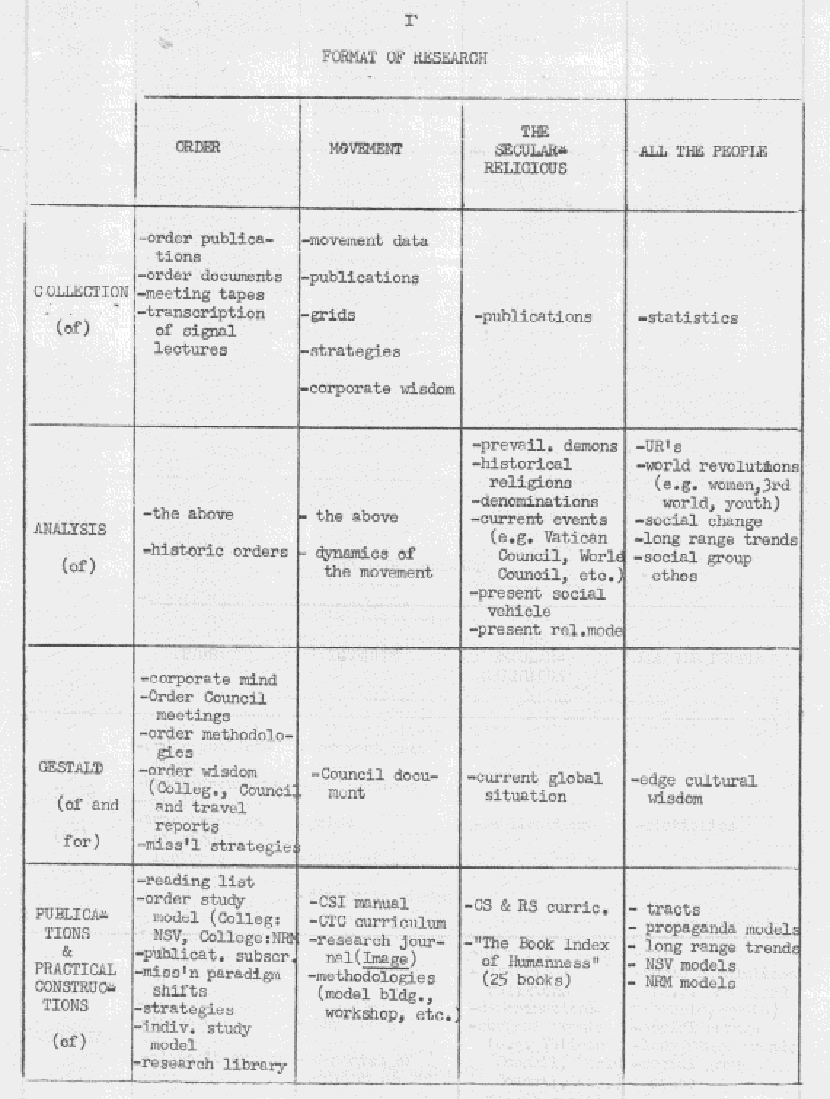
Research Team Two
Order Council '68
Ecumenical Institute
Chicago
THE EDUCATION MATRIX
RELATIONAL PURPOSES: OVERALL GOALS: |
1. to enable the Order to move with a common mind, program and style 2. to enable the movement to stand as colleagues of iron
leadership 3. to enable the church to reeducate every pew occupant 4. to enable the world to see the transparency of its
own being 1. to promote educational structures that infuse the WORD
into every life crisis 2. to train in covenantal life that can effectively ACT
upon every socia1 structure 3. to provide an ordering of knowledge that can illuminate
the AWE in every secular reality 4. to forge an ordering of religious 1ife that forms the
ecstatic STYLE for every sensitive spirit |
RATIONALE FOR THE ORGANIZATIONAL CHART:
The four Action Constructs of the Education Matrix are
associated with four abstract categories: 1. the covenant with all men,
2. the covenant with the historical church, 3. the covenant with the spirit
movement, and 4, the covenant with the order. Secular man includes within
it the churchman, the movement and the order. Churchman includes within
it the movement and the order. The movement includes within it the order.
The order stands as the most limited population of these four areas of
educational responsibility.
|
|
||||
COVENANTAL CATEGORIES |
I. ORDER |
II. MOVEMENT |
III. CHURCHMAN |
IV. SECULARMAN |
EDUCATIONAL PROGRAM |
|
COLLEGE |
|
|
FUNCTIONS (Subsidiary) (Goal) |
. .
1 centralization of paradigm development 2 articulation of corporate mind 3 refinement of curriculum 4 organization of research formats |
1 content intensification 2 methodological prowess 3 missional corporate ness 4 personal healing |
1 curriculum advisement 2 study guidance 3 visionary resources 4 glob1 relations |
1 - priority determination 2 material preparation 3 distribution model 4evaluction model |
ACTION CONSTRUCT |
|
|
|
|
EDUCATION PROGRAM: |
Cadreman Training College |
ACTION CONSTRUCT: |
Cadreman Training College Faculty |
OVERALL FUNCTION: |
To provide the leadership of the movement with the intensification needed for the transformation of the Global Church and driving the global revolution |
FUNCTIONS: |
1. Content Intensification to press to the depths of the ordering of knowledge, practice and style of being 2. Methodological Prowess to achieve clarity and skill in Pedagogy, Social Reformulation and Contemplative practices 3. Missional Corporateness to experience common life responsibility and interdependence in faculty, cadre and college communal forms 4. Religious to enable a fresh conscious decision concerning personal spirit journey and the discipline of contemplation, meditation and prayer |
STRUCTURES: |
1. Recruitment Structure select from regions, check prerequisites 2. Eight Week and Daily Format curriculum, time
structure, work periods and days of celebration 3. College Life Format rubric, rule, covenant, obediences
and accountability 4. Practics Structure structure for children, practical needs, finances and facilities |
TACTICS: |
1. Maximized Participation to involve participants in depth creativity, in teaching and in unit priorship 2. Strict Discipline and Rigorous Accountability to enable serious intentionality toward the engraving of a corporate life style 3. Symbolic Life Emphasis to hold them objectively before the final mystery and the missional task (worship, celebrations, garb, rituals, etc.) 4. Teaching Style to maintain an intimate teaching presence which intensifies the spirit struggle |
EDUCATION PROGRAM: |
Basic Research |
ACTION CONSTRUCT: |
Basic Research Team |
OVERALL FUNCTION: |
The research of the church is the comprehensive investigation of our experimentation with edge cultural wisdom with the aim of clarifying or revising this wisdom in the light of the source of all wisdom: the Word in Jesus Christ The Order in its mission to all men of every time and place and in the midst of an overwhelming information explosion now requires a division "set aside" on behalf of the whole Order to intensify its research function. Thus if the Order is to increase in complexity and continue in unity, it must develop a department of research. This is practical research and the Order itself is the laboratory of inquiry in which the questions are raised, the experiments carried out, data analyzed, conclusions reached, models built and shared for the sake of the future of all men. |
FUNCTIONS: |
1. Centralization of Paradigm Development The department is the center for storage and compilation of the total order's research information and experimental data and the structure for further enablement of the corporate struggle through dimensional extension and experiments with the basic order paradigms. 2. Articulation of Corporate Mind The basic research
team is to make available for every order member in written composition
the substance of the common research as well as public statements in a
research journal. 3. Perfection of Curriculum The research department
is responsible for continually updating the theological and cultural curriculum
and for developing the course construct to freight the new trends in Being
and Style. 4. Organization of Research Formats In order to intensify the overall missional research of the order, the basic research department offers for consensus the general theoretical and practical format for order research councils and other basic projects. |
STRUCTURES: |
1. Research Writing Team A team of twelve men would collect data, prepare written documents, publish a journal and report weekly to the Collegium; the quarterly selection of these men would be based on their writing and pedagogical skills and their depth comprehension of the models and categories of the common mind of the Order. 2. Order Research Council This council would be composed of the heads of the Order divisions and the Research Writing . It would meet triquarterly to prepare a format for the RWT's work and once a quarter to draw up the priorities of a format for the Order Council (the whole body as a research unit). 3. Order Reference Library (Data File) and Bibliography
System The library would be a highly selective collection of edge
materials (books, magazines, articles, films, tapes) for the use of both
the RWT and the Order as a whole. The bibliography would be ordered under
missional, topical headings such as NSV, NRM, the SubAsian UR, practics
of imaginal education and would contain listings of the crucial documents
that the Order Research Council recommends be consulted. 4. Corporate and Individual Study Assignment Model At the end of each quarter the Order Council would offer a model of the next quarter's study assignments for the total Order, the divisions and individuals, as well as specific assignments, study format, crossreferences, questions and a general syllabus. |
TACTICS: |
1. Collection of Reference Materials The department will filter the inflow of data to files, tapes and microfilms for shaping the common memory. 2. Interviews with Direct Sources Direct access
to specialized sources is enabled by travel for interviews and experimental
projects providing raw data to the researching process. 3. Analysis of Historical Trends - Careful analysis of
order functions, movement dynamics and social change gives imaginal form
to the process of history. 4. Models of Trend Formation The production of manuals of operations and methods enables the practical insertion of futuric images into the historical process. |
 |
The Name S__________________
Suggestions: The Community of Revolutionary & Religious Formation
The Conservatory of Contemplative Formation
The Academy of Revolution a Piety
The School of Transformulational Leadership
I. Theoretical Assumptions
A. Purpose
B. Educational Philosophy
C. Uniqueness of Program
D. Relations
A. Content
B. Format
C. Common Life
D. Practics
I. Theoretical Assumptions
The formation of primal pedagogues, social reformulators, and contemplatives who can give
transformulational leadership to the global church.
B. Educational Philosophy
1. Christian community life is the proper context for
training the leadership of the Christian community.
2. Methodology is more important than content.
3. The white hot center of the spirit life is the integrating
motif of the total program.
C. Uniqueness of Program
If Summer '68 was reservist maneuvers, this program is
Officers Training School. In addition to the spirit edge and its practical
meanings, it attempts to provide rigorous academic depth, skills in teaching
total curriculum, and skills in movement practice.
D. Relations
1. Both the Order and the movement leadership receive
this training.
2. This is an autonomous pioneer venture in education
on behalf of all religious and secular education.
3. A diploma will be given yet further training of special sorts will of course be necessary.
II. Practical Construct
A. Content
1. General Methodologies: Study, theological, group, intellectual
2. Pedagogical Methodologies
3. Social Methods: Local Church and Movement
4. Being Turn and Piety Methods
5. Total RS Curriculum with papers on Church History, Old Testament and New Testament
6. Total CS Curriculum with papers on disciplines
7. Kazantzakis and St. John of the Cross
8. Background articles for RS1: e.g. Knox, Kierkegaard and Niebuhr
9. Special Readings: Journey to the East' etc.
10. Use of art, music, movies, etc.
B. Format (See Attached Charts)
C. Common Life
Morning Daily Office with the Order.
Participation in the Office by the students after the first week.
Corporate Solitary Monday through Friday evenings
Individual Solitary Saturday and Sunday evening
2. Meals
Breakfast Scriptures and News
Lunch Structured conversation using as a point of
departure Summer '68 conversations on corporate
life, consensus, etc.
Dinner Kazantzakis and St. John of the Cross Study
(16 sessions each)
3. Work Wednesday 8 A.M. to 12 noon
Wednesday 8 to 12 noon.
The work would be internal such as buffing hall floors,
painting 4th floor bedrooms, etc.
4. Obediences Immediately following lunch 1:15 to
1:30 P.M. Suggest yard pickup
5. Informal Conversation time can take place from 1:30
to 2 P.M., just prior to Siesta.
6. Special Days
Wednesday Dinner.
A special college meal (Ur Image) and special guests or activities.
Example: 1st Wednesday Preparation conversation on individual solitary and making of
rood screens
4 Guest evenings Board of Managers, High School House students, PreSchool faculty, etc.
Short experimental films with art form discussion and
other art form discussions
Saturdays 4 structured Saturdays to demonstrate the power of intentional celebration and
4 free Saturdays for Chicago explorations. Examples of structured Saturdays:
EgoMankind journey, UrImage Tour of Art Institute; Movie, Play, Music production,
Journey to the East, etc.
Sundays Loca1 Church attendance and study.
D. Practics
1. Recruitment. 32 peoples will be selected from among
movement people, order personnel and seminarians. Efforts will be made
to recruit an interracial and international group. In addition to a broad
based selected mailing, intentional recruitment must be done in order to
secure regional participation from across the nation. Absence from the
course will be discouraged.
2. Prerequisites Required: RS1
Recommended: CSI, RSIIIA and CSIIIA
Considered: Family decision to be the church and involvement in regions.
3. Cost. Adults $250 each
Children $100 each.
If finances are a difficulty, we recommend allowing payment
over a period of months.
4. Children. Families will be encouraged to bring their
children. PreSchoolers will be enrolled in EI schools; public school
children, in 5th City schools.
5. Faculty. Four teachers full time. Maintain a faculty/student
ration of 1:8
6. Facilities. Basically one classroom would be needed.
Housing and classes should either be in the Program Center or on campus
with classes held in the chapel basement. In _ to project an academic image
of rigor at every point, it is recommended that the School be somewhat
removed from the common life of the Order.
7. Group Organization. Projecting a group of 32, the group
will be divided into 4 units of 8 members, each of whom will serve as unit
leader for one week.
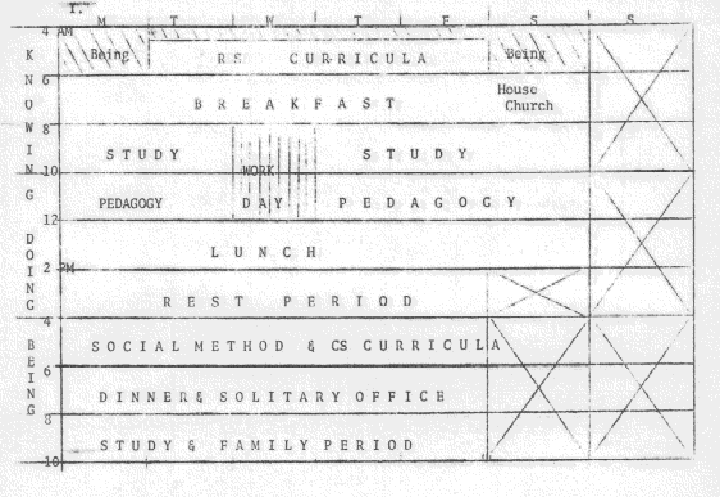 |
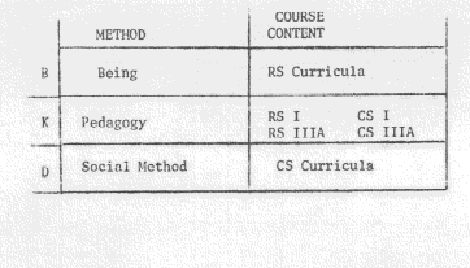 |
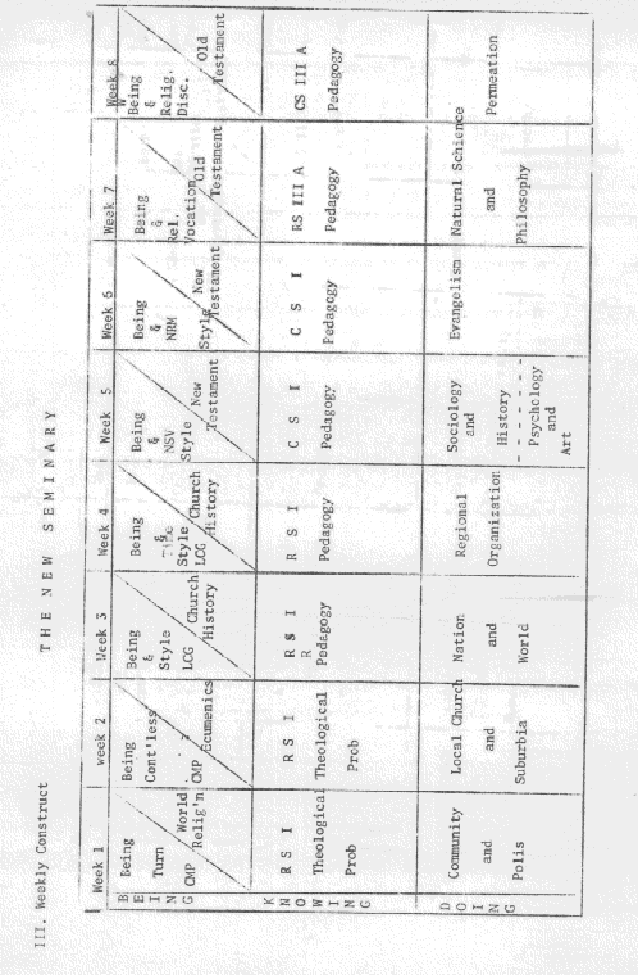 |
EDUCATION PROGRAM: |
General Educational Enablement |
ACTION CONSTRUCT: |
Publishing Centrum |
OVERALL FUNCTION: |
To provide denominations 7 local congregations and individual churchmen with resources for an educational program which creates an expanded cultural and religious awareness and enables them to participate in the revolution which is bringing about a NSV and a NRM. |
FUNCTIONS: |
1. Curriculum Advising informs every churchman by setting a context in which he may appropriate the 20th Century theological and cultural wisdom. 2. Study Guidance approaches every churchman through
his devotional life by providing a digest of readings which will set a
context for beginning the spirit journey. 3. Visionary Resources provides every church men
with data on the evolution of social vehicles and setting a context for
participation in social revolution. 4. Global Relations provides documentation for every churchman on the emerging instances of a world society and sets a context for participation in global mission. |
STRUCTURES |
1. Liaison department channel educational relations with the denominations. 2. Writing Department condense, research and write
articles for publication. 3. Publishing House publish materials for impacting
churchmen. 4. Reference Center - gather, catalog and dispense educational
materials. (The operation of these structures would require a bookstore, printing facilities, mailing service, office space, and secretarial and bookkeeping help.) |
TACTICS: |
1. Open denominational structures to our educational resources. 2. Tailor materials for public consumption. 3. Make available comprehensive educational materials
for practical use. 4. Establish accessible storehouse of resources. |
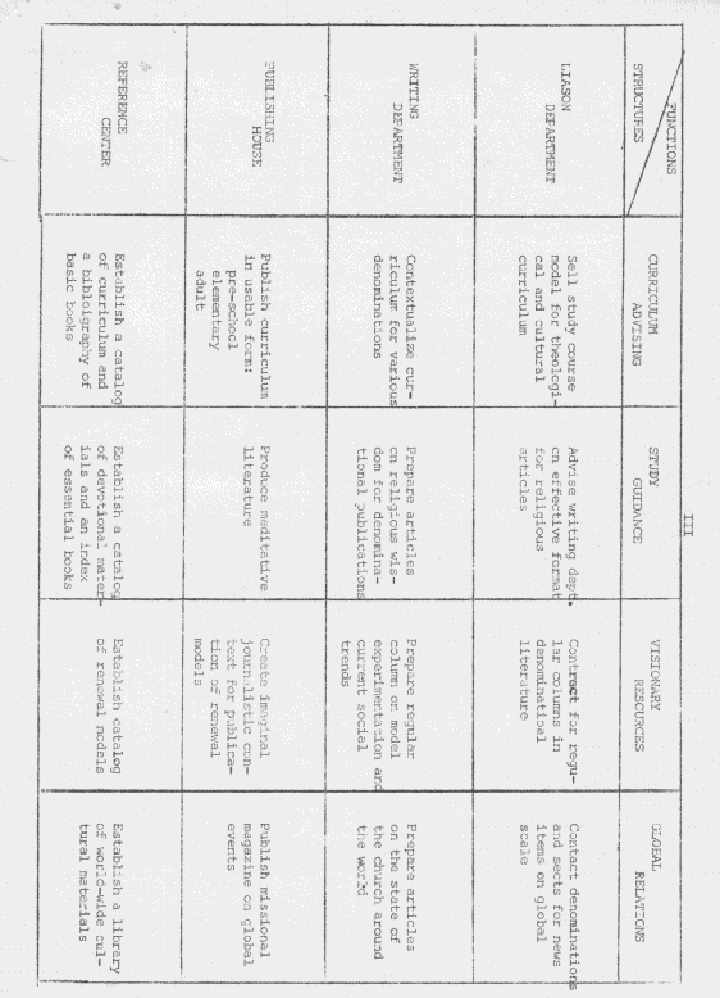 |
EDUCATION PROGRAM: |
Tractarian Formation |
ACTION CONSTRUCT: |
Tractarian Formation Team |
OVERALL FUNCTION: |
The Tractarian Formation Team shall, through the use of mass media education, impact the mass mindset, providing the milieu that permits and indicates the social and religious style in which authentic humanness can take place. |
FUNCTIONS: |
1. Determine Priorities and develop criteria for priority of: a) 1iving groups; b) means of impact (media); c) frequency of impact; d) edge issues. 2. Prepare Material construct propaganda item in
accord with the preselected content and the appropriate media. 3. Order Distribution utilize existing communication
networks to facilitate and coordinate propaganda distribution. 4. Evaluate Effect interpret and evaluate the actual propaganda effects in relationship to the anticipated propaganda effects. |
STRUCTURES: |
1. Target Research Bureau is designed to establish the basic context in which the propaganda effort is carried out. 2. Media Production Center facilitates the actual
development of the content and form of the propaganda as it is intended
for specific groups. 3. Propaganda Direction Centrum coordinates the
actual propagandizing efforts to enable it to effectively impact those
for whom it is intended. 4. Missional Critique Center evaluates the overall effectiveness of the propaganda system in terms of the missional goals and redirects the propaganda effort in appropriate ways. |
TACTICS: |
1. Prepares Analyses to determine the criteria for the selection of recipient groups, media and appropriate issues. 2. Operating Decisions to choose the format, conduct inter-departmental consultations and establish the production schedule. 3. Functional Overview to grid the global communication net work, to maintain quality control and to utilize established movement communications network. 4. Establish Results to discern the actual impact of the propaganda, to schedule periodic evaluation, and to interpret the effects. |